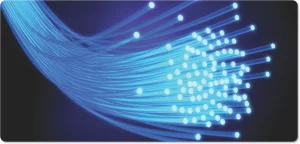Single-Mode vs. Multi-Mode Fiber Cables: Explained

Corporate Technology Solutions is here to help with a thorough explanation of these cables.
Ready to upgrade your network infrastructure? Contact Corporate Technology Solutions today at 877-685-2626 for expert advice tailored to your business needs.
Overview
Single-Mode Fiber Cables
Single-mode fiber cables have a smaller core size, allowing only one mode of light to pass through the fiber. This type of fiber provides higher bandwidth and longer transmission distances. Due to its design, single-mode fiber experiences lower signal attenuation, making it ideal for long-distance data transmission. It operates on a wavelength of 1310 nm or 1550 nm, and due to the single light path, it minimizes signal dispersion.
Multi-Mode Fiber Cables
On the other hand, multi-mode fiber cables have a larger core size, enabling multiple modes of light to pass through the fiber. This design means the signals travel via different paths, leading to more signal and modal dispersion. Multi-mode fiber is commonly used for shorter distances within buildings or data centers, operating on wavelengths of 850 nm or 1300 nm.
In short, the main difference between single-mode and multi-mode fiber cables is that single-mode fiber offers higher bandwidth and longer distances, while multi-mode fiber is better suited for short-range applications.
System Cost
When it comes to system cost, multi-mode fiber cables are generally budget-friendlier than single-mode fiber cables. The components and equipment used with multi-mode fiber are less expensive, making it a cost-effective choice for businesses looking to establish connections over shorter distances.
Single-mode fiber, however, tends to have a higher initial cost due to the more advanced technology and specialized components required for its longer-distance capabilities. Despite the higher upfront investment, single-mode fiber may prove more cost-effective in the long run, especially for businesses with growing networking needs, as it can accommodate higher data rates and longer distances.
Installation Cost
The installation cost of fiber optic cables depends on various factors, including the type of fiber and the network’s complexity. Generally, multi-mode fiber installation is more straightforward and less labor-intensive than single-mode fiber installation.
The larger core size of multi-mode fiber allows for easier connections and is less sensitive to alignment during splicing and termination. As a result, installation time is reduced, lowering overall costs for businesses.
Single-mode fiber, while more challenging to install due to its smaller core size and higher sensitivity to alignment, can offer cost savings when installed for longer distances. The reduced signal loss and higher bandwidth over extended distances can result in lower operational costs over time.
Schedule Service With Corporate Technology Solutions
Choosing between single-mode and multi-mode fiber cables depends on various factors, including your business’s specific needs and budget. Single-mode fiber offers higher bandwidth and longer distances, making it ideal for long-range connections, but it comes with a higher initial cost. Multi-mode fiber, on the other hand, is less expensive initially and better suited for shorter distances within buildings or data centers.
If your business is based in Arizona and you’re looking to upgrade or install a fiber optic network, Corporate Technology Solutions is here to help. With our expertise in structured cabling and fiber optics, we can provide tailored solutions that suit your business requirements.
Schedule a consultation by calling 877-685-2626 and start optimizing your network infrastructure for seamless data transmission.







